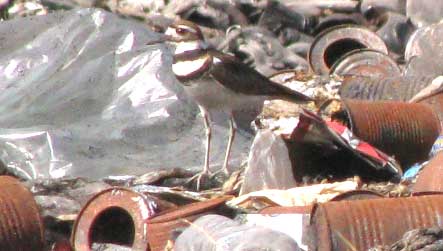Excerpts from Jim Conrad's
Naturalist Newsletter
from the January 16, 2011 Newsletter issued from Hacienda Chichen Resort beside Chichén Itzá Ruins, central Yucatán, MÉXICO; limestone bedrock, elevation ~39m (~128ft), ~N20.676°, ~W88.569°
KILLDEER AT THE GARBAGE DUMP
Early this week it was as hot as later in the week it was cold. One sizzling day when I visited the garbage dump just south of Pisté the wind stirred up fast-moving clouds of reddish dust as it swept across the barren acreage. The usual birds were there, dozens of Black Vultures, Great-tailed Grackles, and a Tropical Kingbird having great luck snapping up flies.
This time, however, there was something special, which I heard before seeing: From high in the sky there came a plaintive kill-DEEE, kill-DEEE, kill-DEEE, the call saying the name of the bird as I knew it growing up on the farm in Kentucky. Books call Killdees by the name of Killdeer, but I've never heard a bird pronounce the final "r." Four birds, their bright orange rumps flashing as they spread their wings to land, touched down on the road. You can see one who quickly ran into the garbage area below:

I've seen the Killdeer at other garbage dumps, so the species clearly has an affinity for dumps -- or at least for the broad horizons that land cleared for dumping provides. That day they seemed perfectly at home even with blinding dust clouds swirling around.
Many birders don't realize that the Killdeer is migratory. Back in Kentucky I didn't know it myself because we saw them year round in our flat, bottomland fields. The deal is that during the summer they nest throughout the US, plus northern Mexico and southern Canada, but spend their winters from the southern half of the US to El Salvador and Honduras. Thus the summer and winter distributions overlap in Kentucky and much of the southern tier of US states. During Kentucky's winters I must have been seeing individuals who nested in Wisconsin or thereabouts. Here in the Yucatan the Killdeer is strictly a winter visitor, though, and this is the first time I've seen one in the interior.